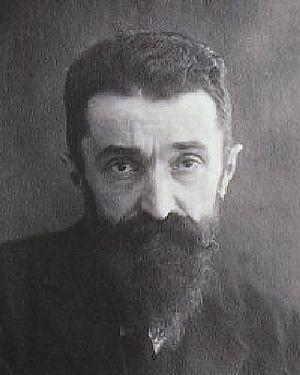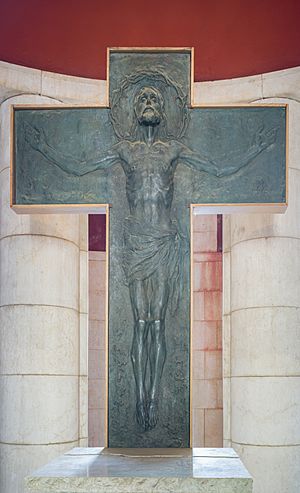Leonardo Bistolfi facts for kids
Quick facts for kids
Leonardo Bistolfi
|
|
|---|---|
 |
|
| Born | 14 March 1859 Casale Monferrato
|
| Died | 2 September 1933 (aged 74) La Loggia
|
| Nationality | Italian |
| Education | Accademia di Belle Arti di Brera |
| Known for | Sculpture |
| Movement | Symbolism Stile Liberty |
Leonardo Bistolfi (14 March 1859 – 2 September 1933) was an Italian sculptor and an important exponent of Italian Symbolism.
Biography
Bistolfi was born in Casale Monferrato in Piedmont, north-west Italy, to Giovanni Bistolfi, a sculptor in wood, and to Angela Amisano.
In 1876 he enrolled in the Brera Art Academy in Milan, where his teacher was Giosuè Argenti. In 1880 he studied under Odoardo Tabacchi at the Accademia Albertina in Turin.
Work
His first works (Le lavandaie (‘The Washerwomen’), Tramonto (‘Sunset’), Vespero (‘Evening’), Boaro (‘Cattle-hand’), Gli amanti (‘The Lovers’)), executed between 1880 and 1885, show the influence of the Milanese Scapigliatura. In 1882 he sculpted L'Angelo della morte (‘The Angel of Death’) for the Brayda tomb in the Turin cemetery known as the Cimitero Monumentale, and in 1883 he produced a bust of the painter Antonio Fontanesi for the Accademia Albertina: these works show a turn towards Symbolism which the artist was never to abandon.
From this time until 1914 Bistolfi produced many busts, medals and portraits of prominent figures including the Piedmontese painter Lorenzo Delleani, the kings of Italy Vittorio Emanuele II and Umberto I, the criminologist Cesare Lombroso, the writer Edmondo De Amicis, and the publisher and journalist Emilio Treves.
In the early 1890s he was made an honorary member of the Accademia Albertina and became secretary of the Circolo degli Artisti (‘Artists’ Circle’).
In 1892 he began a two-year task of decorating Chapel XVI of the Sacro Monte di Crea, one of the Sacri Monti of Piedmont and Lombardy which are recognised as UNESCO World Heritage Sites.
In 1893 he married Maria Gusberti.
Also during the years 1892–1908 Bistolfi executed numerous funerary monuments (statues and reliefs), including the memorial plaque for André Gladis.
In 1902, along with Davide Calandra, Giorgio Ceragioli, Enrico Reycend and Enrico Thovez, he founded the magazine L'arte decorativa moderna (‘Modern Decorative Art’). Between 1895 and 1905 he displayed works at a number of Venice Biennale exhibitions.
In 1906 he produced a monument to the painter Giovanni Segantini La bellezza liberata dalla materia (‘Beauty liberated from matter’) known also as L'alpe (‘the Alp’), which is conserved at the Galleria Nazionale d'Arte Moderna in Rome. For the Monument of Vittorio Emanuele II in Rome Bistolfi produced the marble group Il sacrificio (‘Sacrifice’).
In 1923 he was made a Senatore del Regno (Senator of the Kingdom).
In 1928 Bistolfi produced the Monumento ai Caduti (war memorial) for Casale Monferrato.
Bistolfi died at La Loggia, in the province of Turin, on 2 September 1933. He was interred in the cemetery of Casale Monferrato.
His work is exhibited at La Loggia, at the Musée d'Orsay in Paris, at The National Museum of Western Art in Tokyo, and at the Galleria d'Arte Moderna in Turin. The largest collection, however is at the Gipsoteca “Leonardo Bistolfi” in Casale Monferrato, where more than 170 of his works are on display in five rooms. These include drawings and sketches as well as works and bozzetti in terracotta, plasticine, and gesso and some sculptures in marble and bronze.
Sculpture by Bistolfi is also to be found in the Cimitero monumentale di Staglieno of Genoa, a town where his influence was seen in the work of a number of sculptors, particularly those specializing in funerary art.
See also
 In Spanish: Leonardo Bistolfi para niños
In Spanish: Leonardo Bistolfi para niños


